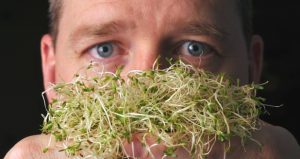Foodborne infections represent a serious and increasing human health problem while at the same time the incidence and prevalence of colitis and the inflammatory bowel diseases (IBDs) are increasing. The origins of these life-threatening syndromes predominantly include environmental factors deduced from studies of genetic twins and other human populations. Pathogen infection has been postulated as a possible environmental trigger of chronic intestinal inflammation and colitis. The Salmonella bacterial pathogen, for example, is widespread throughout the environment and remains a leading cause of human foodborne illness and disease. Salmonella infection can occur by the ingestion of contaminated food products often resulting in acute but temporary intestinal discomfort and dysfunction.
 Possible links between pathogen infections and chronic intestinal inflammation are under increased study. Bacterial infections have been associated with seasonal increases in hospital admissions diagnosing intestinal inflammation and the IBDs. We considered that common repeated infections such as may occur in human food poisoning by Salmonella might be involved in triggering chronic intestinal inflammation. Such infections could be relatively mild, causing few symptoms that go unreported and disappear without clinical intervention, making it possible that there is currently an underappreciation of the numbers of infections occurring among individuals over a life span. We investigated whether low-titer and nonlethal Salmonella infections, designed to model repeated episodes of human food poisoning, may lead to chronic intestinal inflammation and colitis. If so, such a mechanism might be responsible for triggering human inflammatory syndromes including colitis and IBDs.
Possible links between pathogen infections and chronic intestinal inflammation are under increased study. Bacterial infections have been associated with seasonal increases in hospital admissions diagnosing intestinal inflammation and the IBDs. We considered that common repeated infections such as may occur in human food poisoning by Salmonella might be involved in triggering chronic intestinal inflammation. Such infections could be relatively mild, causing few symptoms that go unreported and disappear without clinical intervention, making it possible that there is currently an underappreciation of the numbers of infections occurring among individuals over a life span. We investigated whether low-titer and nonlethal Salmonella infections, designed to model repeated episodes of human food poisoning, may lead to chronic intestinal inflammation and colitis. If so, such a mechanism might be responsible for triggering human inflammatory syndromes including colitis and IBDs.
We developed and characterized a model of human food poisoning in the mouse using recurrent low-dose and nonlethal gastrointestinal infections of a virulent Salmonella isolate. We observed that repeated exposure induced inflammation of intestinal tissues, especially the colon. Although the host effectively cleared the pathogen weeks before reinfection, inflammation and intestinal tissue damage progressively increased in severity with additional infections. In addition, after the cessation of additional infections, inflammation and tissue damage failed to subside and persisted for months throughout the duration of study. We have identified the disease mechanism to be an acquired deficiency of intestinal alkaline phosphatase (IAP), an enzyme produced by enterocytes of the duodenum of the small intestine. IAP dephosphorylates and detoxifies the lipopolysaccharide (LPS) endotoxin produced by commensal microbiota of the host. Salmonella infection induced endogenous neuraminidase (Neu) activity among enterocytes of the duodenum by a Toll-like receptor 4 (TLR4)–dependent mechanism. This elevation of Neu activity accelerated the molecular aging and turnover of IAP, causing IAP deficiency in the colon. IAP deficiency led to elevated levels of LPS-phosphate that provoked TLR4-dependent inflammation. IAP augmentation or neuraminidase inhibition using a marketed antiviral neuraminidase inhibitor were similarly effective at preventing the accumulation of LPS-phosphate and the onset of disease.
We have discovered an environmental and pathogenic origin of chronic intestinal inflammation using a model of recurrent human food poisoning. We further show that this disease can be prevented by either IAP augmentation or Neu inhibition, both of which may represent prophylactic and therapeutic approaches to human colitis and the IBDs.
Recurrent infection progressively disables host protection against intestinal inflammation
Science, vol. 358, issue 6370, Won Ho Yang, Douglas M. Heithoff, Peter V. Aziz, Markus Sperandio, Victor Nizet, Michael J. Maha, DOI: 10.1126/science.aao5610












